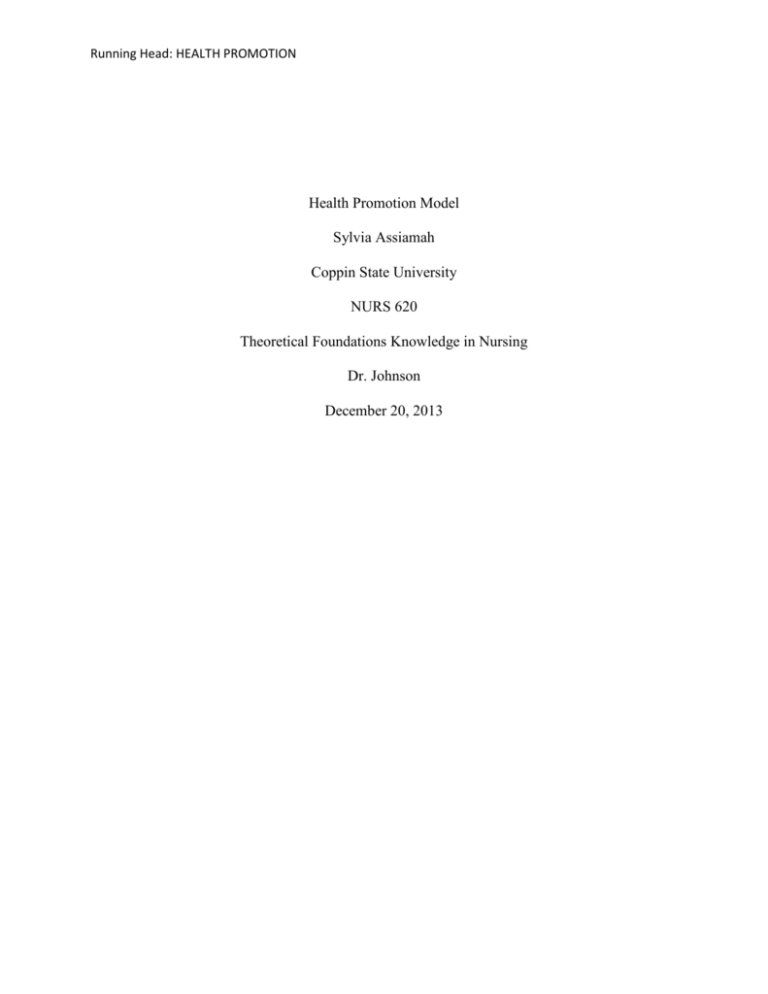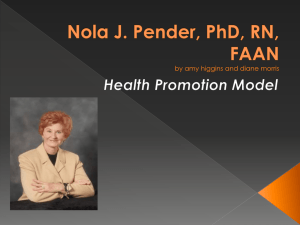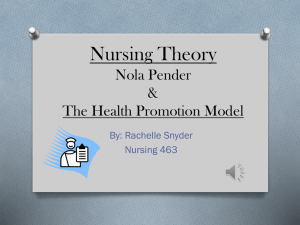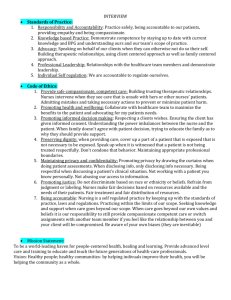File - Life of a Nurse
advertisement

Running Head: HEALTH PROMOTION Health Promotion Model Sylvia Assiamah Coppin State University NURS 620 Theoretical Foundations Knowledge in Nursing Dr. Johnson December 20, 2013 HEALTH PROMOTION The Health Promotion Model (HPM) was developed and published in 1982 by Nola J. Pender. The model was developed as a “framework for research aimed at predicting overall health promoting lifestyles and specific behaviors such as exercise, and use of protective devices” (Alligood & Tomey, p. 439). Since its first publication, the HPM has been revised to include diverse populations, and activities which contribute to the overall health of the individual, family or community. The major concepts associated with the HPM are briefly discussed below: Prior Related Behavior: this concept determines the extent to which past behaviors are has an influence on present health promoting behaviors. Personal Factors: The extent to which biological, psychological, and sociocultural predicts or shapes the individual(s) health promoting activities. Perceived Benefits of Action: the benefits which are earned as a result of embarking on health activities. Perceived Barriers to Action: known or imaginary obstacles, such as finances, which may impede health promoting activities. Perceived Self-Efficacy: A self-awareness of one’s strengths and how it motivates the individual to pursue and achieve health promoting behaviors. Activity – Related Effect: interplay of how other activities unrelated to health promotion, affect the individual outlook on health promotion activities. Interpersonal Influences: how the various relationships in the individual(s) life affect their participation in health promotion behaviors. 2 HEALTH PROMOTION Situational Influences: how the unforeseen and unpredicted activities influence the individual, or whether unexpected situations gear the individual toward, or steer the individual from partaking in health promotion activities. Commitment to a Plan of Action: Specific plans outlined to ensure health promotion strategies. Immediate Competing Demands and Preferences: this includes family, friends, school, work, all of which are important elements of the individual’s life, but when not managed properly can be deterrence to the achievement of health promoting behaviors. Health Promoting Behavior: includes activities such as exercising, eating a healthy diet, managing stress, nurturing ones’ self spiritually, ensuring sufficient rest, all of which aims to generate positive health outcomes (Alligood & Tomey, p 438 – 439). Aligwood & Tomey (2010), identify the major assumptions of the health promotion model as a “reflection of behavioral sciences and emphasize the active role of the patient in managing health behaviors by modifying the environmental context” (p. 441). Nola J Pender, in her own words, states the following assumptions: 1. Persons seeks to create conditions of living through which they can express their unique human health potential 2. Persons have the capacity for reflective self- awareness; including assessment of theory own competencies. 3. A person value growth in directions viewed as positive and attempts to achieve a personally acceptable balance between change and stability. 4. Individuals seek to actively regulate their own behavior 3 HEALTH PROMOTION 5. Individuals in all their biophysical complexity interact with the environment progressively transforming the environment and being transformed overtime 6. Health professionals constitute a part of the interpersonal environment, which exerts influence on persons throughout their life spans. 7. Self-initiated reconfiguration of person environment interactive patterns is essential to behavioral change (Alligwood & Tomey, 2010, as adopted from Nola Pender, Nursing Practice, 1996, p. 54-55). The framework of the HPM is to provide people with the right tools, while guiding and assisting the individual to make choices which will contribute to greater health. A person’s biopsycosoial environment is multifaceted, and influences the individual’s overall course of action towards health. The model does not provide a quick fix solution to a health problem. What it does, is to assist the individual assess their environment for tools to influence behavioral outcomes, in a positive manner. The concepts outlined in Pender’s model are theoretical and operationally defined. The concepts of prior related behavior, personal factors, perceived benefits of action, perceived barriers to action, perceived self-efficacy, activity related affect, interpersonal influences, situational influences, commitment to a plan of action, immediate competing demands and preferences, and health promoting behaviors, are explained by Pender in an operational context, as well as theoretical assertions. Operationally, the concepts are defined to explain how an individual’s characteristics and experiences affect subsequent health actions. Theoretically, Pender outlines the biopsycosocial processes, which motivate individual(s) to embark upon healthy behaviors, targeted toward enrichment of health. 4 HEALTH PROMOTION The Pender health promoting model has a diagram which interlocks the various aspects of the model. The diagram has three main headings outlined as; individual characteristics and experiences, behavior specific cognitions and affect, and behavioral outcome. The diagram pictorially explains that, individual characteristics and experiences influence certain behavior specific conditions and affect, and this in turn influences the behavioral outcome of the individual. The health promotion model has been accepted and integrated into nursing practice. According to Aligwood & Tomey (2010), “current state-of -the -art clinical practice includes health promotion activities, as nursing professionals find the HPM very relevant because it is diversified, and applies to populations and communities of varied backgrounds, and life span” (p. 442). An important nursing function is patient education. As nurses seek ways to limit the effect of diseases in patients, they work with patients to promote healthy behaviors which contribute to disease prevention and optimal disease management. Nurse practitioners are advanced nurse practitioners whose functions among other things include the role of health promotion. Nurse practitioners “are trained in health promotion, disease prevention, and medical management and are well equipped to treat patients in primary care” (Harrington, 2011). As primary care providers, nurse practitioners utilize the health promotion model to motivate patients to be responsible for their health, through health promoting behaviors and activities which lead to positive outcomes. Numerous research studies have been done, using the health promotion model as a theoretical framework for the study. Mohamadian et al. (2011), assert that the modifiable variables of selfefficacy, perceived barriers, and social support concepts, in the HPM, were found to be strong predictors of a health promoting life. In the discussion of their study, Mohamadian et al. 5 HEALTH PROMOTION conclude that nurses and other healthcare providers can use the HPM to yield behavior modification interventions, which leads to a health promoting lifestyle. In another article, Ho, Berggren, Dahlborg-Lyckhage (2010) explain how the health promotion model, can be used a tool, in the management of diabetes. As a global health problem, diabetes is a lifelong disease, which requires a life time commitment to treatment and management. The authors conclude in their research article that “it is beneficial to use the HPM in diabetes empowerment, as it provides a framework for explaining clients’ health behaviors, and there by enable health-care professionals to assist clients to overcome their barriers and enhance their self-efficacy in relation to lifestyle modification” ( Ho, Berggren, DahlborgLyckhage, 2010). To determine the probability of nurses providing health promotion activities as part of nursing interventions for their patients, Esposito & Fitzpatrick (2011), conclude that “the prospect of impacting the personal exercise behaviors of nurses and potentially influencing the health behaviors of others is in alignment with the tenets of health promotion and large scale population health management”. The research indicates that when healthcare providers adopt health promoting lifestyles, there are likely to recommend similar strategies for their patients. The health promotion model adopted in the early 80’s has grown to be accepted worldwide, regardless of culture or social backgrounds. As individual, organizations, state and federal governments seek to find ways to cut down the growing problem of healthcare costs, the HPM has generated many health promoting lifestyle programs targeted towards motivating individuals to attain personal health. The health promotion model since its inception has been revised and currently serves as a framework for many primary care models. Aligwood & Tomey (2010), relay the importance of 6 HEALTH PROMOTION the theory stating how “Pender and colleagues have conducted a program of research funded by the National Institute of Nursing Research to evaluate the HPM in four populations; working adults, older community dwelling adults, ambulatory cancer patients, and patients undergoing cancer rehabilitation” (Aligwood & Tomey, p. 439). Based on these studies, the model has been revised and currently contributes to advanced nursing practice. Currently, nursing professionals incorporate the HPM into their diverse practice settings, because it has relevance across the life span. The HPM provides ample opportunity for advanced nurse practitioners to develop and implement health promotion activities among varied populations in different stages of the life span. Nurse practitioners, can promote healthy behaviors amongst their patient(s), by performing the functions of; researcher, educator, health promoter, care provider, collaborator, ethics/legislator, and leader. Each of the prior mentioned roles “contributes to a nursing solution to health policy and healthcare reform by providing a means for how consumers can be motivated to attain personal health” (Aligwood & Tomey, p. 442). 7 HEALTH PROMOTION 8 References Alligood M. R., & Tomey, A. M. (2010). Nursing Theorists and Their Work (7th ed.). Missouri: Mosby/Elsevier. Esposito, E., & Fitzpatrick, J. (2011). Registered nurses' beliefs of the benefits of exercise, their exercise behavior and their patient teaching regarding exercise. International Journal Of Nursing Practice, 17(4), 351-356. Harrington, S. (2011). Mentoring new nurse practitioners to accelerate their development as primary care providers: A literature review. Journal Of The American Academy Of Nurse Practitioners, 23(4), 168-174. Ho, A., Berggren, I., & Dahlborg-Lyckhage, E. (2010). Diabetes empowerment related to Pender's Health Promotion Model: a meta-synthesis. Nursing & Health Sciences, 12(2), 259-267. Mohamadian, H., Eftekhar, H., Rahimi, A., Mohamad, H., Shojaiezade, D., & Montazeri, A. (2011). Predicting health-related quality of life by using a health promotion model among Iranian adolescent girls: A structural equation modeling approach. Nursing & Health Sciences, 13(2), 141-148.







